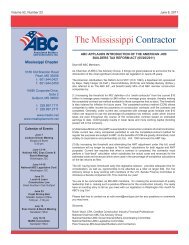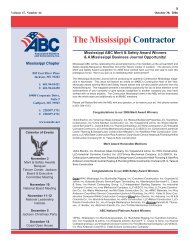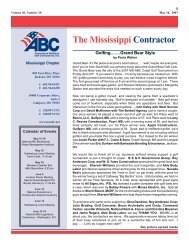§1904.1090<strong>OSHA</strong> RECORDKEEPINGAwareness Campaign). The recording level is alsocompatible with the definition of material impairmentused by <strong>OSHA</strong> and MSHA in the development ofstandards for occupational noise exposure (64 FR49548, 48 FR 9738).The hearing loss recording requirements inSection 1904.10 differ from the requirements of the<strong>OSHA</strong> noise standard (Section 1910.95) becauseunder the noise standard the employer is required totake certain actions (employee notification, providinghearing protectors or refitting of hearing protectors,etc.) for all 10-db standard threshold shifts while thepart 1904 rule only requires the recording of STSsthat also exceed the total 25-db level. <strong>OSHA</strong> believesthat this is an appropriate policy, because 10-db shiftsin hearing at higher levels (above 25 dB) are moresignificant….When audiometric testing is done, test tones arepresented at various sound levels, usually increasingor decreasing in 5-dB steps. The employee is askedto respond whenever a tone is heard, with the goalbeing finding the lowest level at which the employeecan consistently hear. The standard measurement formeasuring hearing level is decibels, a logarithmicscale. For the first increase in hearing level from 0 to10 dB, the sound intensity increases 10 fold. The next10 dB is a 100-fold increase. By the time a person’shearing level changes from 0 to 30 dB hearing level,he or she needs 1,000 times more sound intensity tojust barely hear.Although the part 1904 recordkeeping regulationand the Section 1910.95 noise standard treat the STScases differently, this has no effect on the noise standard’srequirements and does not have any effect onthe requirement for employers to comply withSection 1910.95. When employers detect work-relatedSTS cases, they are required to take all of the follow-upactions required by the noise standard.Additionally, the STS measure uses existingmeasurements and calculations employers arealready using to comply with the <strong>OSHA</strong> noise standard,resulting in less paperwork burden for employerscovered by both rules. Employers are required totake one additional step to determine if the STS hasalso resulted in a total hearing level of 25 dB ormore, and if so, to record it. The position taken inSection 1904.10 provides a reasonable compromisebetween the commenters’ highly polarized views onthe proper recording level. The final rule’s hearingloss recording provisions provide a reasonable “middleground” solution to reconcile the differencesbetween a highly sensitive measure of hearing loss(all 10-db shifts) and increasingly insensitive measures(15, 20, or 25-db shifts).The approach used in this final rule is a newlydeveloped alternative that was not considered in theJanuary 2001 rulemaking because none of the commentersto the 1996 proposed rule suggested it….<strong>OSHA</strong> believes that the Section 1904.10 requirementswill improve the nation’s statistics on occupationalhearing loss and that more hearing loss caseswill be entered on employers’ <strong>OSHA</strong> 300 Logs.However, <strong>OSHA</strong> recognizes that the new requirementsmay not result in comprehensive statistics foroccupational hearing loss. Employees may experiencesignificant hearing loss in industries whereaudiometric testing is not required (construction,agriculture, oil and gas drilling and servicing, andshipbuilding industries), and is not provided voluntarilyby the employer, and thus never be enteredinto the records. Likewise, an employee may experiencegradual hearing loss while employed by severalemployers, but never work for the same employerlong enough to allow a recordable STS to be captured.As to the effect on trend analysis, caution mustbe used when comparing Section 1904.10 hearingloss data that span the effective date of this rule.The new hearing loss recording rule will result in therecording of additional cases of hearing loss, not as aresult of a change in the number of workers whoexperience hearing loss, but simply because of therecordkeeping change.<strong>OSHA</strong> finds that recording only 25-dB shifts fromthe employee’s baseline audiogram is not an appropriatepolicy. If an employee had significant hearingloss before being hired by the employer, additionalhearing loss would not be recorded until well beyondthe point of disability. This would not conform to therequirements of section 24 of the Act directing theSecretary to “[c]ompile accurate statistics on workinjuries and illnesses which shall include all disabling,serious, or significant injuries and illnesses * * *”(emphasis added) (29 U.S.C. 673). The recording of25-dB shifts in hearing acuity, measured from theemployee’s original baseline audiogram would clearlyunderstate the true incidence of work-related hearingloss. Likewise, if the part 1904 regulation were torequire only the recording of 15 or 20-dB shifts, orcategorically exclude the first STS case the rulewould exclude many legitimate and serious hearingloss cases that should rightfully be entered into therecords and the Nation’s injury and illness statistics.This approach would be especially deficient at capturinghearing loss in those employees who changeemployers several times during their working lives….<strong>OSHA</strong> does not agree with the commenters whoHANDBOOK
argued that because the function of the <strong>OSHA</strong> standardsand regulations, including the part 1904 regulation,is to protect workers, worker protection wouldbe compromised by any policy other than the recordingof all STS cases. <strong>OSHA</strong> encourages employersand employees to use the <strong>OSHA</strong> injury and illnessrecords to improve workplace safety and health conditions,and this is one of the functions of the Part1904 records. However, this is not the only functionof the records. They are also used to generate injuryand illness statistics for the Nation and for individualworkplaces. They are used by <strong>OSHA</strong> representativesto identify hazards during workplace inspections, andare collected by <strong>OSHA</strong> to target its interventionefforts to more hazardous worksites (See 66 FR 5916-5917). As stated in the 2001 rulemaking, “[n]o newprotections are being provided by the recordkeepingrule”. Further, the OSH Act does not require therecording of all injuries and illnesses and specificallyexcludes certain minor injury and illness cases. Thisexclusion, which is discussed in the preamble to theJanuary 19, 2001 final rule, applies to both injuriesand illnesses, including hearing loss (See 66 FR 5931-5932). It is thus entirely appropriate for the recordkeepingrule to exclude certain minor illness caseswhile capturing more serious cases.The hearing loss recording requirements ofSection 1904.10 will not deprive employers andemployees of information about noise hazards ordiminish workers’ protection against the hazards ofnoise in the workplace. The occupational noise exposurestandard requires that employees in generalindustry be tested for hearing loss when noise exposureexceeds an 8-hour time-weighted average of85dB, and that employees be informed, in writing, ifa 10-dB shift has occurred. The audiometric testrecords must be retained for the duration of theaffected employee’s employment. (See 29 CFR1910.95(g), (m)). The noise standard also specifies theprotective measures to be taken to prevent furtherhearing loss for employees who have experienced a10-dB shift, including the use of hearing protectorsand referral for audiological evaluation where appropriate.(See 29 CFR 1910.95(g)(8)). These requirements,which apply without regard to the recordingcriteria in the recordkeeping rule, will protect workersagainst the hazards of noise. The modified requirementsof Section 1904.10 will therefore not depriveemployers and workers of the means to detect andprevent hearing loss.Finally, section 4(b)(4) of the OSH Act providesthat “[n]othing in this Act shall be construed tosupercede or in any manner affect any workmen’s<strong>OSHA</strong> RECORDKEEPINGcompensation law or to enlarge or diminish or affectin any other manner the common law or statutoryrights, duties, or liabilities of employers and employeesunder any law with respect to injuries, diseases,or death of employees arising out of, or in the courseof, employment.” 29 U.S.C. 653(b)(4). Accordingly, the<strong>OSHA</strong> recordkeeping rule will have no legal effect onstate workers’ compensation systems. There is noevidence that the states have modified their systemsto conform to <strong>OSHA</strong>’s previous hearing loss recordingpolicies; in fact, the states are far from uniform intheir treatment of occupational hearing loss. Therefore,<strong>OSHA</strong> does not expect the 1904 regulation tohave any effect on state workers’ compensation inthe future.Audiometric Error…<strong>OSHA</strong> agrees … that the recordkeeping rule shouldnot take any actions to address the issues of audiometricvariability, and finds that there is no need toincrease the recording loss threshold to 15 or 20 dBto account for variability. The <strong>OSHA</strong> noise standardincludes provisions that standardize audiometric testingprotocols. The requirements in Section 1910.95(g) Audiometric Testing Program, Section 1910.95 (h)Audiometric Test Requirements, Mandatory AppendixC to Section 1910.95 Audiometric MeasuringInstruments, Mandatory Appendix D to Section1910.95 Audiometric Test Rooms, and MandatoryAppendix E to Section 1910.95 Acoustic Calibrationof Audiometers, and the incorporated provisions ofAmerican Standard Specification for AudiometersS3.6-1969 provide standardized methodologies forconducting hearing tests designed to assure, as faras possible, that audiograms are accurate….It should be noted that it is impossible to eliminateaudiometric errors in their entirety. Any recordinglevel, no matter how it is set, will be subject tosome level of false positive and false negative errors.However, <strong>OSHA</strong> believes that the audiometric testingrequirements of Section 1910.95, if followed, will providereasonably accurate audiometric data for theadministration of the <strong>OSHA</strong> noise standard, and forthe recording of occupational hearing loss. As . . .commented: “(f)ollowing a standardized testing protocol(using 29 CFR 1910.95), and including adjustmentsfor age and the use of a retest in 30 days, hasprovided accurate, consistent results.” <strong>OSHA</strong> believesthat the provisions allowing the employer to ageadjust audiograms, seek advice from a physician orother licensed health care professional for determiningwork-relationship, retest within 30 days, andremove cases later found not to be persistent provideHANDBOOK91§1904.10
- Page 1 and 2:
www.osha.govOSHARecordkeepingHandbo
- Page 3 and 4:
OSHARecordkeeping HandbookThe Regul
- Page 5 and 6:
ContentsRecordkeeping HandbookRoadm
- Page 7 and 8:
Section 1904.40Providing records to
- Page 9 and 10:
Section 1904.0Purpose(66 FR 6122, J
- Page 11 and 12:
Section 1904.1Partial exemption for
- Page 13 and 14:
Section 1904.2Partial exemption for
- Page 15 and 16:
employees, to OSHA within 8 hours (
- Page 17 and 18:
Partial Exemptions for Employers Un
- Page 19 and 20:
Section 1904.4Recording criteria(66
- Page 21 and 22:
Section 1904.5Determination of work
- Page 23 and 24:
(b)(7) How do I decide if a case is
- Page 25 and 26:
well, including providing informati
- Page 27 and 28:
This exception, which responds to i
- Page 29 and 30:
or she is in the work environment a
- Page 31 and 32:
have occurred but for the occupatio
- Page 33 and 34:
considered work-related. If an empl
- Page 35 and 36:
Question 5-12. Is work-related stre
- Page 37 and 38:
• The doctor described the illnes
- Page 39 and 40:
Scenario 7:• A site hired numerou
- Page 41 and 42:
Letter of interpretation related to
- Page 43 and 44:
These principles should be applied
- Page 45 and 46:
The problem with the response is tw
- Page 47 and 48: Section 1904.6Determination of new
- Page 49 and 50: the Guidelines stated that “the a
- Page 51 and 52: estricted work. If the case is a pr
- Page 53 and 54: • The doctor also prescribed the
- Page 55 and 56: • The employees were under the di
- Page 57 and 58: Section 1904.7General recording cri
- Page 59 and 60: (iii) Do I have to record restricte
- Page 61 and 62: of the length of time the employee
- Page 63 and 64: then result in days away from work
- Page 65 and 66: A partial day of work is recorded a
- Page 67 and 68: In all other respects, the final ru
- Page 69 and 70: ments. The Agency believes that the
- Page 71 and 72: e recorded because it will require
- Page 73 and 74: However, episodes of fainting from
- Page 75 and 76: care professional, he or she may al
- Page 77 and 78: “Other simple means” of removin
- Page 79 and 80: For purposes of OSHA recordkeeping
- Page 81 and 82: • When answering the doctor’s q
- Page 83 and 84: Response: In the recordkeeping regu
- Page 85 and 86: Letter of interpretation related to
- Page 87 and 88: Section 1904.8Recording criteria fo
- Page 89 and 90: caused by contaminated needles and
- Page 91 and 92: Section 1904.9Recording criteria fo
- Page 93 and 94: Section 1904.10Recording criteria f
- Page 95 and 96: hearing loss case that is not relat
- Page 97: average of 10 decibels or more at 2
- Page 101 and 102: occurs, and where hearing loss can
- Page 103 and 104: cases in their workplace via analys
- Page 105 and 106: March 4, 2004Mr. Carl O. Sall, CIHD
- Page 107 and 108: When the professional evaluating th
- Page 109 and 110: (2) May I line-out or erase a recor
- Page 111 and 112: Section 1904.12Recording criteria f
- Page 113 and 114: These new statistics would add only
- Page 115 and 116: Sections 1904.13 - 1904.28 Reserved
- Page 117 and 118: two lines of the OSHA 300 Log to de
- Page 119 and 120: which replace the OSHA 200 and 101
- Page 121 and 122: different types of occupational ill
- Page 123 and 124: OSHA 301 form. These data are usefu
- Page 125 and 126: LETTERS OF INTERPRETATION: Section
- Page 127 and 128: Question 2: Under 29 CFR Section 19
- Page 129 and 130: and has adopted language in the fin
- Page 131 and 132: Section 1904.31Covered employees(66
- Page 133 and 134: label assigned to a worker is immat
- Page 135 and 136: These workers should be evaluated j
- Page 137 and 138: Response: A case is work-related if
- Page 139 and 140: Response: Section 1904.31 states th
- Page 141 and 142: Thank you for your interest in occu
- Page 143 and 144: year covered by the summary. The su
- Page 145 and 146: 2. Number of employees and hours wo
- Page 147 and 148: LETTERS OF INTERPRETATION: Section
- Page 149 and 150:
Section 1904.33Retention and updati
- Page 151 and 152:
June 23, 2003Mr. Edwin G. Foulke, J
- Page 153 and 154:
Section 1904.34Change in business o
- Page 155 and 156:
PREAMBLE DISCUSSION: Section 1904.3
- Page 157 and 158:
Incident Report (Forms 300 and 301,
- Page 159 and 160:
workers’ compensation claim. See
- Page 161 and 162:
LETTERS OF INTERPRETATION: Section
- Page 163 and 164:
Letter of interpretation related to
- Page 165 and 166:
Question 3: Using the facts in Ques
- Page 167 and 168:
Section 1904.37State recordkeeping
- Page 169 and 170:
tion, require employers to report f
- Page 171 and 172:
(5) If I receive a variance, may th
- Page 173 and 174:
Section 1904.39Reporting fatalities
- Page 175 and 176:
gation. Therefore, the final rule d
- Page 177 and 178:
Section 1904.40Providing records to
- Page 179 and 180:
ness. The government inspector may
- Page 181 and 182:
Response: The controlling employer
- Page 183 and 184:
FREQUENTLY ASKED QUESTIONS: Section
- Page 185 and 186:
OSHA and the BLS have worked togeth
- Page 187 and 188:
provide copies of the retained reco
- Page 189 and 190:
FREQUENTLY ASKED QUESTIONS: Section
- Page 191 and 192:
Section 1904.46Definitions(66 FR 61
- Page 193 and 194:
of business information. For exampl
- Page 195 and 196:
inconvenience associated with keepi
- Page 197 and 198:
skin disease, respiratory disorder,
- Page 199 and 200:
Question 2: Under 29 CFR Section 19
- Page 201:
www.osha.gov







